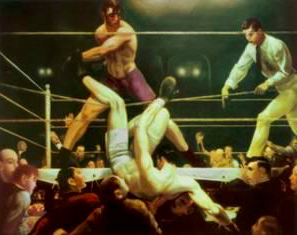
Panorama of the Nyack Post Office murals showing the scenes painted on the east and south walls.
by Mike Hays
The hand-painted, WPA-era murals that cover most of the upper part of the high-ceiling, art deco style Nyack Post Office have survived intact for the last 83 years. But how much longer will the murals last? Some of the murals depict a bygone way of life that has been the object of at least one protest.
The Nyack Post Office

Post office shortly after it was built. It looks much the same today. Photo courtesy of the Nyack Library.
Construction of the current Nyack Post Office began in 1932. The land for the post office had been acquired from the Depew family some 40 years prior. The Victorian house on the lot was moved across the street (now the home of Art Café) to make room for a post office; however, it took a long time to fund the building. The Nyack Rotary Club supplied the final pressure-gathering 2,000 signatures on a petition asking that the Post Office finally be built.
During its early days in the 1930s, the WPA was located in the building. But like the murals, the Post Office building itself is unchanged. It sports two claw-footed metal lanterns with white globes on either side of the granite front steps. Above the door is a classic Art Deco frieze.
TRAP (WPA) Post Office Murals
From 1934-1943, the government funded around 1,400 post office murals in an effort to put artists to work during the Depression. Popularly known as a WPA program, mural artists were actually hired and administered through the TRAP program, the Treasury Department Section of Art and Sculpture, using WPA funding. Muralists were selected by competitions. Of the 850 artists selected, only 162 were women and only three were African American.
Milton Avery was one of the artists who painted murals. Mark Rothko, Jackson Pollock, Willem de Kooning, and Ben Shan also won grants for other WPA-funded projects. A Cape Cod postmaster once approached Edward Hopper about a post office mural, but Hopper turned him down.
The government stipulated that mural scenes should show ordinary American life in a realistic manner. Abstraction and modernism were not allowed. The government carefully scrutinized designs and works in progress. Only upon approval of each stage were artists paid.
The “Ashcan” and American Social Realism Painting Styles

Bellows’ Dempsey and Firpo, 1924. Courtesy of the Whitney Museum of American Art
An art movement started in reaction to impressionism was popular around the same time as the murals. Its origins are usually attributed to a group of artists in Philadelphia known as the Ashcan School for its realistic painting style and choice of industrial settings and scenes of everyday life.
Social realism pushed the style a bit further by showing alienation and the plight of the working poor–as seen in the work of New York artists like George Bellow and Edward Hopper, as well as American heartland artists, such as Thomas Hart Benton and Grant Wood. George Bellows’ boxing paintings, with their hyper-masculine protagonists and bloodthirsty audience, is an iconic example of this style, and its hallmarks show up in the Nyack Post Office murals.
Jacob Getlar Smith
Born in the Bronx in 1898, Jacob Getlar Smith studied realistic painting techniques at the National Academy of Design. Early on, his view was that “the artist should be a seeing-eye dog for a myopic Civilization.” His everyday scenes were meant to explore a moral work ethic with a hint of political protest.
Smith was lucky to get a Guggenheim fellowship in 1929. However, when the fellowship was finished he went hungry, like so many Americans at that time. Three post office projects were sponsored in Rockland County: Spring Valley got a small mural, Suffern a plaster relief, and Nyack got a large-scale mural.
Jacob Getlar Smith’s sketches were approved for the Nyack Post Office in mid-1934 and Smith, along with his assistant Jacob Pelzman, completed the murals in 1936. Smith went on to paint one more post office mural in Salisbury, Maryland. He was a member of Edward Hopper’s American Realist Journal. He turned to watercolors later in his career and wrote the book, Watercolor Painting for the Beginner, in which he advocates students “learn the lesson of understatement.” Smith died in 1958.
The Post Office Murals
In Nyack’s Post Office, the murals wrap around three sides of the building. Stylized trees surround the postal cage on the north end. Smith uses the same tree structure to separate six different scenes as they wrap around the long eastern wall and onto the shorter southern side. The scenes depict a history of the Hudson River valley. The Hudson River flows in the background of each scene.
Hyper-masculine Native Americans and colonists populate the first three scenes culminating in a scene that depicts the 1634 Kieft’s War. Smith dramatizes the colonial struggle in a disturbing manner by showing Native Americans attacking a homestead. In the background, a Native American burns the house; another is killing the plow ox; another is engaged in a mortal battle with a colonist; and another is strangling a woman and about to strike her with a tomahawk.
The final three scenes move the history forward from the revolutionary war to the late 19th century. In a a Civil war era scene, a young African American man kneels at the feet of a farmer, and a woman stands behind the two gazing away in fear. Another figure is carrying a knapsack on a pole in the background. Is the farmer helping runaway slaves? Perhaps. It is either that or he is a post-emancipation liberator. Either way, he is depicted as a savior.
Taken together, the mural illustrates a cultural history true to its time. Hard working, white, male colonists earn the right to own land. They fight off savages and protect women. They fight and defeat the British and slavery. Their reward is hard-won prosperity. Clearly, it is a one-sided story.
The murals sparks protests
In 1973, Herb Fass, a stained glass artist from South Nyack, began a protest against the portrayal of Native Americans in the mural. Fass was an unusual individual. He sued a Nyack bank for $1 million over a billing error setting up a booth on the sidewalk outside the now defunct Chemical Bank. He was also in favor of eliminating the penny as it caused too much work at banks. And he favored eliminating mail envelopes as an unnecessary waste of paper.
The postal service refused his request to replace the panel with a donated painting of a Native American in a peaceful landscape. He invited Maryann Redcloud Lerner, an Oglala Sioux from Whippany NJ, to view the panel. She suggested that a new panel be added showing white peoples’ brutality against Native Americans. A Journal News poll of 12 people showed that the mural offended no one. A Nyack businessman stated that it was part of our heritage. “Besides it is so pretty,” he said.
The mural begs the question: Are unique and treasured artworks guaranteed a place in our daily life if they depict a world-view at odds with the current one of multi-cultural equal rights advocacy?
Photo Credits: Photos by Mike Hays
Michael Hays is a 30-year resident of the Nyacks. He grew up the son of a professor and nurse in Champaign, Illinois. He has recently retired from a long career in educational publishing with Prentice-Hall and McGraw-Hill. He is an avid cyclist, amateur historian and photographer, gardener, and dog walker. He has enjoyed more years than he cares to count with his beautiful companion, Bernie Richey. You can follow him on Instagram as UpperNyackMike.

 Nyack People & Places, a weekly series that features photos and profiles of citizens and scenes near Nyack, NY, is brought to you by HRHCare and Weld Realty.
Nyack People & Places, a weekly series that features photos and profiles of citizens and scenes near Nyack, NY, is brought to you by HRHCare and Weld Realty.














